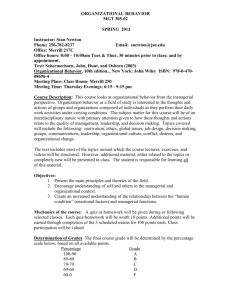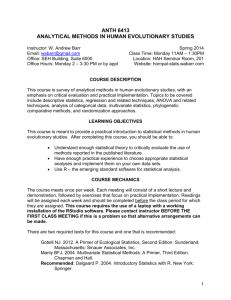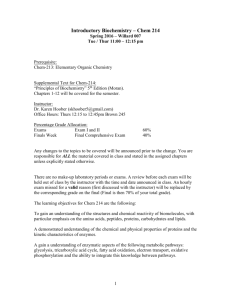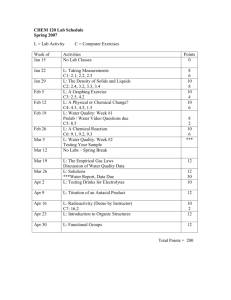In-Class Participation Grading Scale
advertisement
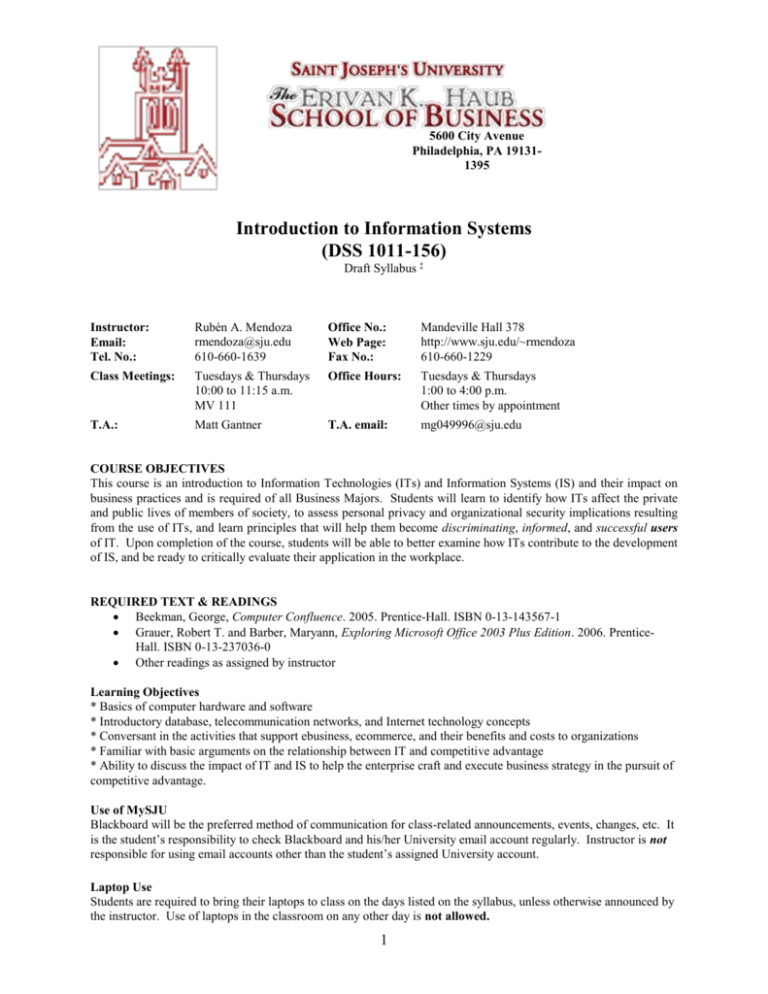
5600 City Avenue Philadelphia, PA 191311395 Introduction to Information Systems (DSS 1011-156) Draft Syllabus ‡ Instructor: Email: Tel. No.: Rubén A. Mendoza rmendoza@sju.edu 610-660-1639 Office No.: Web Page: Fax No.: Mandeville Hall 378 http://www.sju.edu/~rmendoza 610-660-1229 Class Meetings: Tuesdays & Thursdays 10:00 to 11:15 a.m. MV 111 Office Hours: Tuesdays & Thursdays 1:00 to 4:00 p.m. Other times by appointment T.A.: Matt Gantner T.A. email: mg049996@sju.edu COURSE OBJECTIVES This course is an introduction to Information Technologies (ITs) and Information Systems (IS) and their impact on business practices and is required of all Business Majors. Students will learn to identify how ITs affect the private and public lives of members of society, to assess personal privacy and organizational security implications resulting from the use of ITs, and learn principles that will help them become discriminating, informed, and successful users of IT. Upon completion of the course, students will be able to better examine how ITs contribute to the development of IS, and be ready to critically evaluate their application in the workplace. REQUIRED TEXT & READINGS Beekman, George, Computer Confluence. 2005. Prentice-Hall. ISBN 0-13-143567-1 Grauer, Robert T. and Barber, Maryann, Exploring Microsoft Office 2003 Plus Edition. 2006. PrenticeHall. ISBN 0-13-237036-0 Other readings as assigned by instructor Learning Objectives * Basics of computer hardware and software * Introductory database, telecommunication networks, and Internet technology concepts * Conversant in the activities that support ebusiness, ecommerce, and their benefits and costs to organizations * Familiar with basic arguments on the relationship between IT and competitive advantage * Ability to discuss the impact of IT and IS to help the enterprise craft and execute business strategy in the pursuit of competitive advantage. Use of MySJU Blackboard will be the preferred method of communication for class-related announcements, events, changes, etc. It is the student’s responsibility to check Blackboard and his/her University email account regularly. Instructor is not responsible for using email accounts other than the student’s assigned University account. Laptop Use Students are required to bring their laptops to class on the days listed on the syllabus, unless otherwise announced by the instructor. Use of laptops in the classroom on any other day is not allowed. 1 GRADING Final course grade will be assigned based on the following scale. Please note that extra-credit work is not available at any point during the term. In-Class Exam 1 In-Class Exam 2 Final Exam MS Office Assignments - Four - 75 points each Individual Participation TOTAL 200 points 200 points 200 points 300 points 100 points 1000 points Class Attendance Attendance will be taken during this course and students are expected to attend all classes and examinations as scheduled. Absences totaling more than 3 sessions during the semester may result in an Administrative Failure grade (FA). Occasionally, students will be required to attend presentations or lectures by guest speakers during Free Periods. These also count towards course attendance and will not exceed three (3) during the term. Final Grade Distribution A 920-1000 points A890-919 points B+ 860-889 points B 830-859 points B800-829 points C+ C CD F 770-799 740-769 700-739 600-699 0-599 points points points points points In-Class Participation Grading Scale * 100 points - Regular contributions 75 points - Frequent contributions 50 points - Occasional contributions 25 points - Rare contributions 10 points - No contributions made 1 point - Disruptive classroom, computing, telephone behaviors * In-between scores at instructor’s discretion Make-up Exam Policy Students are expected to be present for all in-class examinations as listed on the syllabus or announced by the instructor. Missed exams will result in a grade of zero (0) points for that exam. Make-up exams will be permitted only in case of valid, documented medical absences (family emergencies included). Valid documentation of an absence must be requested through the Dean’s Office and presented to the instructor in order to reschedule an exam. There will be no exceptions made to this policy. STUDENTS WITH DISABILITIES If you have a documented disability (learning, physical, psychological) for which you are or may be requesting reasonable academic adjustments, you are encouraged to contact Services for Students with Disabilities, 113 Science Center, 610-660-1774 or 610-660-1620 as early as possible in the semester. 2 COURSE SCHEDULE ‡ DATE Jan 18 Jan 20 Jan 25 Jan 27 Feb 1 Feb 3 Feb 8 Feb 10 Feb 15 Feb 17 Feb 22 Feb 24 Mar 1 Mar 3 Mar 8 Mar 10 Mar 15 Mar 17 Mar 22 Mar 24 Mar 29 Mar 31 Apr 5 Apr 7 Apr 12 Apr 14 Apr 19 Apr 21 Apr 26 Apr 28 TOPICS Course Overview & Introduction READINGS & ACTIVITIES Chapters 0, 1, 12 Hardware Chapter 2 Software Chapters 4, 6.1 (pp. 218-219) Exam 1 MS Office Basics (Word) MS Office Basics (Excel) Databases MS Office Basics (Access) Networking & Telecommunications Spring Break – No Class Chapter 5, GB-XP Chapter 1, PC GB-XL Chapter 1, 3, 5, PC Word assignment due Chapters 7, 15 GB-AX Chapters 1-4, PC Excel assignment due Chapter 8 Networking & Telecommunications Chapter 8 Internet Technologies Chapter 9 Access assignment due Chapter 13 Olsen (2004), Patton (2001), Sawhney (2002), Varon (2001) eCommerce & eBusiness Exam 2 MS Office Basics (PowerPoint) Security & Risks IT & Competitive Advantage PC, GB-PPT Chapter 1, PC Chapter 10 HowStuffWorks.com article, Kirkpatrick (2004) Brynjolfsson & Hitt (1998) HTML Tutorial PC IS in Business Group Assignment Due Key: PC = Bring laptop to class (required) GB = Grauer & Barber text where XP = Win XP; XL = Excel; AX = Access; PPT = PowerPoint) Readings (links on Blackboard): Brynjolfsson, E., and Hitt, Lorin M. (1998). "Beyond the productivity paradox." Communications of the ACM 41(8): 49-55. HowStuffWorks.com: “How Identity Theft Works.” URL: http://ibs.howstuffworks.com/ibs/den/identity-theft.htm Olsen, S. (2004). "Exposing click fraud." C|Net News.com. URL: http://news.com.com/Exposing+click+fraud/2100-1024_3-5273078.html Patton, S. (2001) "The ABCs of B2C.” CIO.com URL: http://www.cio.com/ec/edit/b2cabc.html Sawhney, M. (2002) "Putting the Horse First," CIO.com URL: http://www.cio.com/archive/051502/netgains.html Varon, E. (2001) "The ABCs of B2B." CIO.com URL: http://www.cio.com/research/ec/edit/b2babc.html ‡ Contents and dates subject to change. Guest Speakers may be featured during the term, depending on availability and appropriateness to the topics being discussed. 3
